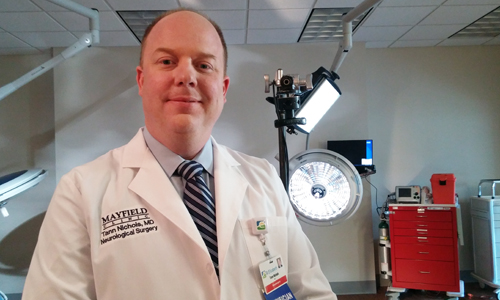
By Tann Nichols, MD
For as long as there has been sentient life on earth, there has been pain. And for most of human history, it has been grim. Our ancestors endured surgery without anesthesia, amputations without hospitals, high-risk childbirth without a doctor. Their pain came from any number of sources, from infected teeth to broken bones to cancer.
They expected to feel pain. A hundred years ago, pain was a natural part of life. It was especially a natural part of aging. As you got older, things hurt. Everyone knew that as they got older, they would live with some degree of pain.
Of course, sometimes pain can be helpful. Don’t stick your hand in the fire. Don’t run on the broken leg. But in the modern world, for the most part pain is just a pain.
I treat patients who suffer pain, and I know their suffering is as real for them today as it was for their forebears generations ago. What has changed is our expectations about pain. We no longer think of pain as being part of life. Pain is not natural anymore. There is an expectation that we should all be pain-free forever and ever until our lives magically come to an end.
And this is a problem. Our expectations are often too high.
I told an associate who is facing surgery, “You are still going to hurt. Not as much. You’ll be better, hopefully, but there will still be some pain. It’s natural.”
This is the price we pay for living and growing old.
Of course there are many things medical professionals do to help people with their pain. We prescribe medications, administer injections, provide physical therapy, perform surgery, and – in situations of stubborn, chronic pain – implant spinal cord stimulators that block pain signals to the brain.
But despite these treatments, there may still be pain. So doctors and patients alike must take responsibility for this fact. We must manage our expectations and control pain as effectively and intelligently as we can.
Here are three important steps patients and their healthcare providers can take:
• Analyze the course of your day. How does your pain rise and fall based on what you do? If your back hurts more when you perform certain activities – when you lift a grandchild or sling a bale of hay – you might do well to avoid those activities. Have someone place the child on your lap; get help at work or sling smaller bales.
• Analyze the amount of medication you are taking. If your pain is the same whether you take 4 pills a day or 2, cut back to 2. Always take the smallest number of pills possible.
• Investigate alternative therapies, such as Yoga and meditation. Talk to your doctor about an exercise program that is appropriate for your condition. Simply having a pet can reduce anxiety and pain.
Most important, take a step back and reconsider your attitude toward pain. Letting go of the idea that you can live pain-free your entire life may help you cope with the discomforts that you have. Recognizing pain as a normal, inevitable part of life won’t make your pain go away. But it may free you to focus on other, enjoyable parts of your life – your friends, your family, your activities. The goal is to control your pain, not let it control you.